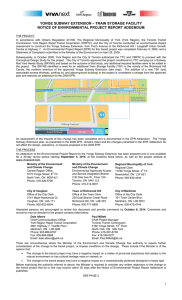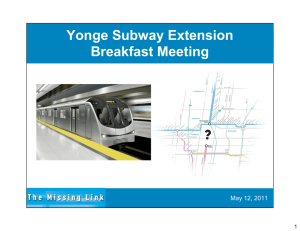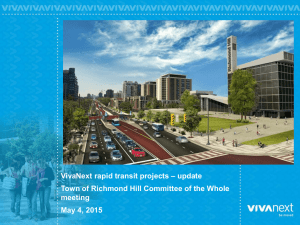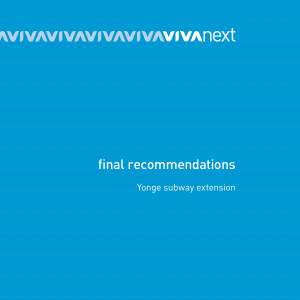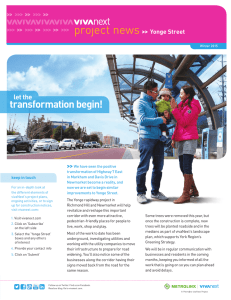York Region Rapid Transit Corporation / Transit Project Assessment Process
advertisement
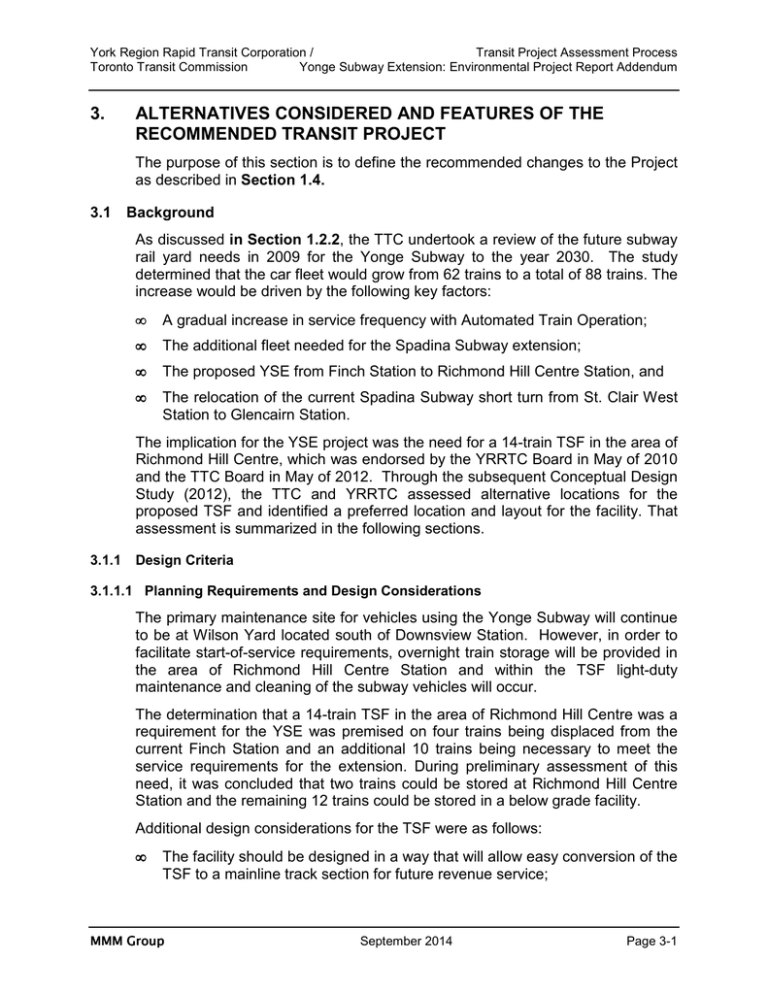
York Region Rapid Transit Corporation / Transit Project Assessment Process Toronto Transit Commission Yonge Subway Extension: Environmental Project Report Addendum 3. ALTERNATIVES CONSIDERED AND FEATURES OF THE RECOMMENDED TRANSIT PROJECT The purpose of this section is to define the recommended changes to the Project as described in Section 1.4. 3.1 Background As discussed in Section 1.2.2, the TTC undertook a review of the future subway rail yard needs in 2009 for the Yonge Subway to the year 2030. The study determined that the car fleet would grow from 62 trains to a total of 88 trains. The increase would be driven by the following key factors: • A gradual increase in service frequency with Automated Train Operation; • The additional fleet needed for the Spadina Subway extension; • The proposed YSE from Finch Station to Richmond Hill Centre Station, and • The relocation of the current Spadina Subway short turn from St. Clair West Station to Glencairn Station. The implication for the YSE project was the need for a 14-train TSF in the area of Richmond Hill Centre, which was endorsed by the YRRTC Board in May of 2010 and the TTC Board in May of 2012. Through the subsequent Conceptual Design Study (2012), the TTC and YRRTC assessed alternative locations for the proposed TSF and identified a preferred location and layout for the facility. That assessment is summarized in the following sections. 3.1.1 Design Criteria 3.1.1.1 Planning Requirements and Design Considerations The primary maintenance site for vehicles using the Yonge Subway will continue to be at Wilson Yard located south of Downsview Station. However, in order to facilitate start-of-service requirements, overnight train storage will be provided in the area of Richmond Hill Centre Station and within the TSF light-duty maintenance and cleaning of the subway vehicles will occur. The determination that a 14-train TSF in the area of Richmond Hill Centre was a requirement for the YSE was premised on four trains being displaced from the current Finch Station and an additional 10 trains being necessary to meet the service requirements for the extension. During preliminary assessment of this need, it was concluded that two trains could be stored at Richmond Hill Centre Station and the remaining 12 trains could be stored in a below grade facility. Additional design considerations for the TSF were as follows: • The facility should be designed in a way that will allow easy conversion of the TSF to a mainline track section for future revenue service; MMM Group September 2014 Page 3-1 York Region Rapid Transit Corporation / Transit Project Assessment Process Toronto Transit Commission Yonge Subway Extension: Environmental Project Report Addendum • The next station on the line, forming part of a future northern extension, should be located in close proximity to the Yonge Street/16th Avenue intersection; and • The facility should be designed in a way that any future construction of a northerly extension should not impact or disrupt train storage or train operation. 3.1.1.2 Operational Requirements The following operational requirements were compiled following several meetings with TTC Subway Operations: • The facility will be below grade/enclosed and will be used for storage, as well as light-duty maintenance and cleaning of the vehicles; • Maintenance crew will access/egress the underground facility from the Richmond Hill Centre Station Platform, from EEB #8 provided in the vicinity of the TSF; • Trains entering revenue service will be delivered by maintenance crew to the south end of the Richmond Hill Centre Station platform to be picked up by the operator, and • The facility will be staffed overnight to perform light-duty maintenance and cleaning of the vehicles, and to provide a permanent presence (overnight security) in the facility. 3.1.1.3 Supporting Facility Requirements The following facilities were similarly developed with TTC Subway Operations as part of the Conceptual Design Study, to support the operation of the underground TSF: • A transportation reporting centre; • A parking lot for 25-30 spaces premised on 13-14 people needed to bring trains into operation; • Cargo elevator; • Garbage storage room, and • Small office, lunch room and locker room. An assessment of the traction power and electrical requirements for the TSF has identified the need for an Electrical Service Building including a high voltage room, communication room, emergency power room, HVAC mechanical room and a switchgear-switchboard room. An assessment of the ventilation requirements for the YSE including the TSF has identified the need for an emergency ventilation fan, a fan room and a ventilation shaft to be located at the north end of the TSF. MMM Group September 2014 Page 3-2 York Region Rapid Transit Corporation / Transit Project Assessment Process Toronto Transit Commission Yonge Subway Extension: Environmental Project Report Addendum 3.1.2 Alignment and Configuration Alternatives In order to address the requirements identified in Section 3.1.1, during the Conceptual Design phase, alternative TSF alignments were developed, reviewed and analysed in the vicinity of the Richmond Hill Centre. These included options which extended under Yonge Street north of the Langstaff Station, under the commuter parking lot within the hydro corridor and extending easterly within the hydro corridor north of Highway 7. Figure 3-1 displays the train storage options studied. Each option was compared, based on the following criteria: • Future Station Location; • Subway operations; • Not to preclude a future extension of the Yonge Subway north from Richmond Hill Centre; • Property and building impacts; • Constructability (traffic, property, tunneling versus open cut); and • Cost (initial and future). All options developed would remain underground. Based on a high-level screening assessment, Options 3, 4 and 5 did not meet the design criteria and were not pursued further for the following reasons: Option #3 • Significant constructability issues with building under the Highway 407 bridge; • Operational issues with trains backtracking to Richmond Hill Centre; and • Requires property for facility building along Yonge Street. Option #4 • Constructability issues with building between major highways and under rail corridor; and • Special track work increases the distance between Richmond Hill Centre Station and Langstaff/Longbridge station. Option #5 • Significant environmental impacts expected as train storage extends into West Don River Valley; and • Operational issues associated with reverse movements of trains in and out of the mainline. MMM Group September 2014 Page 3-3 York Region Rapid Transit Corporation / Transit Project Assessment Process Toronto Transit Commission Yonge Subway Extension: Environmental Project Report Addendum Figure 3-1: Train Storage Options Studied in the Conceptual Design MMM Group September 2014 Page 3-4 York Region Rapid Transit Corporation / Transit Project Assessment Process Toronto Transit Commission Yonge Subway Extension: Environmental Project Report Addendum The following were the key considerations regarding the remaining two location options: Option #1 • Requires Bantry bridge to be rebuilt; • Minimizes impacts to existing property; • Minimizes impacts to transit/traffic on Yonge Street during Construction; • Lower capital costs expected; • Shorter than Option #2; • More efficient operation for storage facility; • Associated TTC surface facilities located off of Yonge Street; • Future 16th Avenue station platform located approximately 150m east of Yonge Street; and • Potential impacts on future development. Option #2 • More impact on transit and traffic on Yonge Street during construction; • Longer and therefore more expensive than Option #1; • Impacts a number of existing residential properties that would need to be expropriated; • Pushes future 16th Avenue station north of 16th Avenue; • Less efficient storage operation as trains would have to be stored in tunnels; • Associated TTC surface facilities located close to Yonge Street; and • No impact to the Bantry Bridge. Option #1 was expanded to include an additional option at the same location that involved four parallel tracks as compared to three. These three alternatives were developed further for detailed assessment. These were renamed: • Alignment Alternative A (Bi) - construction of a three-track structure extending north from the Richmond Hill Centre Station adjacent to the existing CN Rail corridor; (See Figure 3-2); • Alignment Alternative B (Cii) - construction of a two-track storage tunnel extending north from the Richmond Hill Centre Station and curving westerly to run under the Yonge Street road alignment (See Figure 3-3), and • Alignment Alternative C (Gi) - construction of a four-track storage structure extending north from the Richmond Hill Centre Station adjacent to the existing CN Rail corridor. (See Figure 3-4). MMM Group September 2014 Page 3-5 York Region Rapid Transit Corporation / Transit Project Assessment Process Toronto Transit Commission Yonge Subway Extension: Environmental Project Report Addendum This page intentionally left blank. MMM Group September 2014 Page 3-6 York Region Rapid Transit Corporation / Transit Project Assessment Process Toronto Transit Commission Yonge Subway Extension: Environmental Project Report Addendum This page intentionally left blank. MMM Group September 2014 Page 3-10 York Region Rapid Transit Corporation / Transit Project Assessment Process Toronto Transit Commission Yonge Subway Extension: Environmental Project Report Addendum 3.1.3 Evaluation of Alternatives and Selection of Preferred Alignment These three options were evaluated in terms of; 1. Train Storage Facility: 1.1. Land use types adjacent to storage facility; 1.2. Construction method required; 1.3. Traffic impacts as a result of cut-and-cover construction; 1.4. Number of buildings and structures within the tunnel easement; 1.5. Number of potential noise and vibration-sensitive receptors within 100m of the storage facility; 1.6. Horizontal and vertical alignments – compliance with TTC standards; 1.7. Approximate length of storage facility; 1.8. Encroachment on the CN rail corridor; 1.9. Location of ancillary facilities (e.g. staff parking, office, ventilation shafts, EEBs, etc.); 1.10. Construction cost; and 1.11. Residential property acquisition cost. 2. Protection for future subway extension to 16th Avenue: 2.1. Location of the future 16th Avenue station relative to the intersection of Yonge Street and 16th Avenue; 2.2. Number of redevelopment sites bisected by of crossed by tunnel easement; 2.3. Number of buildings and structures within the tunnel easement; 2.4. Horizontal and vertical alignments – compliance with TTC design standards; 2.5. Construction method required; 2.6. Future subway construction allowances (i.e.future TBM exit shaft or future ventilation shaft); 2.7. Impact of future extension to 16th Avenue on the train storage facility; 2.8. Impact on subway turnback operation at Richmond Hill Centre Station; 2.9. Additional tunneling cost to extend to future 16th Avenue Station; and 2.10. Residential property acquisition cost ($2011, est.). MMM Group September 2014 Page 3-11 York Region Rapid Transit Corporation / Transit Project Assessment Process Toronto Transit Commission Yonge Subway Extension: Environmental Project Report Addendum The following matrix (see Table 3-1) summarizes the technical evaluation of these various alignment alternatives, as presented in the Conceptual Design Study. Based on this evaluation Alignment Alternative A (Bi) (see Figure 3-2) was selected as the recommended alternative. It should be noted that the final alignment of the TSF has been subsequently refined to address the need to avoid the existing caisson foundations for the condo located at 29 Northern Heights Drive and the need to establish tunnel/station easements for proposed new developments by landowners on the east side of Yonge Street south of 16th Avenue. MMM Group September 2014 Page 3-12 York Region Rapid Transit Corporation / Transit Project Assessment Process Toronto Transit Commission Yonge Subway Extension: Environmental Project Report Addendum Table 3-1: Summary of Assessment of Alternatives Alternative Bi Measure Alternative Cii Alternative Gi Note Construction of a 3-track storage structure extending north from the Richmond Hill station adjacent to the existing CN Rail corridor. Description Construction of a 2-track storage tunnel extending north from the Richmond Hill station and curving westerly to run under the Yonge Street road alignment Construction of a 4-track storage structure extending north from the Richmond Hill station adjacent to the existing CN Rail corridor. 1.0 Train Storage Facility 1.1 Land use types adjacent to storage facility General description 1.2 Construction method required General description Mostly residential to the west. CN rail corridor to the east. Mostly residential to the west. CN rail corridor to th east. ◕ ◔ ◕ Cut-and-cover between CN rail corridor and residential properties Tunneling under residential properties from Beresford Drive to 60m north of Oak Avenue/Northern Heights Drive . Cut-and-cover between CN rail corridor and residential properties (wider construction area than Alternative Bi) ◕ ◕ ◑ Low - requires partial lane closure on Coburg Crescent and Beresford Drive. Access to residential properties can be maintained. Low to Medium - requires lane closures on Yonge Street around Oak Avenue Low - requires partial lane closure on Coburg Crescent and Beresford Drive. Access to residential properties can be maintained. ◕ ◑ ◕ Commercial - Office 1 (50 High Tech) 1 (50 High Tech) 1 (50 High Tech) Commercial - Retail 0 1 0 Residential - Townhouse Units 0 53 0 1 (Bantry Avenue) 0 1 (Bantry Avenue) 1.3 Traffic impacts as a result of cut-and-cover construction Preliminary assessment 1.4 Number of buildings and structures within the tunnel easement tunnel easement defined as a 30 to 32m swath centred on tunnel reference line Overpass 1.5 Number of potential noise and vibration sensitive receptors within 100m of the storage facility Residential and commercial on both sides Preliminary - to be confirmed by future studies 1.6 Horizontal and vertical alignments - compliance with TTC Design Standards ◕ ◔ ◕ 210 townhouse units 4 apartment buildings 179 townhouse units 4 apartment buildings 121 townhouse units 2 apartment buildings ◔ ◑ ◕ Complies with technical design standards Complies with technical design standards Complies with technical design standards ● ● ● 820 metres 1049 metres 630 metres ◕ ◔ ● No No Yes 1.7 Approx. length of storage facility 1.8 Encroachment on CN rail corridor 1.9 Location of anciliary facilities (e.g. staff parking, office, ventilation shafts, EEBs, etc.) ● ● Can be accommodated within the train storage facility easement between the adjacent townhouses and the CN rail corridor. Will need to be accommodated off Yonge Street on existing commercial/retail properties on the west side of Yonge Street commercial/business impact. ◑ Can be accommodated within the train storage facility easement between the adjacent townhouses and the CN rail corridor. 1.10 Construction Cost Initial review would indicate similar capital costs for all 3 alternatives. 1.11 Residential Property Acquisition Cost MMM Group Based on the number of units affected (See 1.4) multiplied by average neighbourhood sales price between April 2010 and April 2011. Intended for qualitative comparison only - does not represent actual property acquisition cost. No residential property acquisition anticipated September 2014 $22,655,000 No residential property acquisition anticipated Page 3-13 York Region Rapid Transit Corporation / Transit Project Assessment Process Toronto Transit Commission Yonge Subway Extension: Environmental Project Report Addendum Measure Alternative Bi Alternative Cii Alternative Gi 120 metres east of the intersection At the intersection 120 metres east of the intersection ◕ ● ◕ Note 2.0 Future Subway Extension to 16th Avenue 2.1 Centroid of the station platform relative to centre of the intersection Location of the future 16th Avenue Station relative to the intersection of Yonge Street and 16th Avenue Option Cii situated at equal distance between Hillcrest Mall and South Hill Plaza station box could straddle the intersection or positioned further north to connect with any preferred entrance location. 2 (Great Lands, Haulover) 2.2 Number of redevelopment sites bisected or crossed by tunnel easement 2.3 Number of buildings and structures within the tunnel easement Despite the subway tunnels crossing the development sites, consultation with land owners indicated that impact on site plan and built-form will be minimal. 2 (Great Lands, Haulover) ◕ ● ◕ Residential - Townhouse Units 37 0 37 Residential - Condominium Units 198 0 198 tunnel easement defined as a 30 to 32m swath centred on tunnel reference line 2.4 Horizontal and vertical alignments - compliance with TTC Design Standards General description 2.5 Construction method required 0 2.6 Future subway construction allowances (ie future TBM exit shaft or future ventilation shafts) ◔ ● ◔ Complies with technical design standards Complies with technical design standards Complies with technical design standards ● ● ● Tunneling under residential properties from the north end of the storage facility to the station box at 16th Avenue. Cut-and-cover for station box. Tunelling or cut-and-cover for 250 metres of tunnels between the north end of the storage facility and 16th Avenue Station. Cut-and-cover for station box. Tunneling under residential properties from the north end of the storage facility to the station box at 16th Avenue. Cut-and-cover for station box. ◔ ◕ ◔ Yes Yes (extraction shaft within Yonge Street ROW) Yes ● ◕ ● 2.7 Impact of future extension to 16th Avenue on the train storage facility Storage facility must be relocated in Storage facility must be relocated in Storage facility must be relocated in the future the future the future 2.8 Impact on subway turnback operation at Richmond Hill Centre Station Permits provision of double-ended pocket tracks north of the station platform. Two turnback options. Can accommodate train headways that are less than 3 minutes and 30 seconds. Excludes the ability to provide double-ended pocket tracks north of the station platform. One turnback option. Limits the ability to operate trains at headways less than 3 minutes and 30 seconds. Permits provision of double-ended pocket tracks north of the station platform. Two turnback options. Can accommodate train headways that are less than 3 minutes and 30 seconds. ● ◔ ● $22 Million (430 metres) $13 Million (250 metres) $31 Million (620 metres) $17,848,000 No residential property acquisition anticipated $17,848,000 ◕ ◑ ◕ ◑ ◕ 2.9 Additional Tunnelling Cost to Extend to Future 16th Excludes station at 16th Avenue. Based on Avenue Station (2011$) length of tunnels multiplid by unit cost for twin tunnelling ($50,000 per metre). Includes tunnel boring, tunnel liners, and finishes only. Does not include contingencies or mark-ups. 2.10 Residential Property Acquisition Cost (2011$) Based on the number of townhouse units affected (See 2.3) multiplied by average neighbourhood sales price between April 2010 and April 2011. Intended for qualitative comparison only - does not represent actual property acquisition cost. Includes a $5 Million placeholder for monitoring/remedial work on condo at 29 Northern Heights Drive. SUMMARY Legend ◔ MMM Group ● Most Preferred Least Preferred September 2014 Page 3-14 York Region Rapid Transit Corporation / Transit Project Assessment Process Toronto Transit Commission Yonge Subway Extension: Environmental Project Report Addendum 3.2 Update of the Project Description The purpose of this section is to define the recommended changes to the Project as described in Section 1.4.2. The YSE plan, as presented in the 2009 EPR remains intact, and the changes presented herein do not affect the design, operations, or impacts assessed in the 2009 EPR. As discussed in Section 1.4.2, this Addendum addresses a proposed extension of the proposed YSE to accommodate an underground Train Storage Facility north of the previouslyidentified terminus of the proposed YSE at Richmond Hill Centre Station. The following sections describe the revised Project within the defined Addendum study area. 3.2.1 Subway Extension Alignment The implementation of the proposed Train Storage Facility would require an underground extension of the Yonge Subway of approximately 800m beyond the end of the approved Richmond Hill Centre Station. The subway extension would continue northerly along the west side of the rail corridor to minimize encroachment on the residential development to the west of the rail corridor. The subway alignment would rise at an approximate 3% grade as it continues northerly from the Station, with the top-of-rail remaining at an elevation approximately 20m below surface grade. North of the Station, cross-over tracks would be provided to facilitate the transfer of trains to/from the centre track of the storage facility. Crossover tracks are required to facilitate subway operations in this corridor. Crossovers enable trains to transfer between mainline tracks in order to change direction or for failure management purposes (such as manoeuvering around a disabled train). In this facility, the crossover track north of Richmond Hill Centre Station would allow for trains being put into /taken out of service to transfer between the storage facility and the main line. The final alignment of the TSF would encroach on the current CN right-of-way and a subsurface easement will be required. Based on initial consultation with CN, the following CN non-residential criteria for development next to the rail line are applicable to the proposed TSF: • A minimum 15 metre building setback, from the railway right-of-way, is recommended for heavy industrial, warehouse, manufacturing and repair use (i.e. factories, workshops, automobile repair and service shops); • A chain link fence of minimum 1.83 metre height is required to be installed and maintained along the mutual property line; • Any proposed alterations to the existing drainage pattern affecting Railway property require prior concurrence from the Railway and be substantiated by a drainage report to the satisfaction of the Railway; and, MMM Group September 2014 Page 3-15 York Region Rapid Transit Corporation / Transit Project Assessment Process Toronto Transit Commission Yonge Subway Extension: Environmental Project Report Addendum • Noise and vibration impacts of the project should be evaluated; if the construction of the facility changes the acoustic environment of the immediate setting, it could trigger new discomfort (due to the railway or other sources) for nearby occupants. Further consultation with CN Rail will be required in subsequent design stages to ensure CN Guidelines and Standards are met. The proposed extension of the YSE is presented in Figure 3-5A to C. 3.2.2 Train Storage Facility The proposed underground Train Storage Facility would be located adjacent to the CN Rail corridor, beginning approximately 100m north of the Richmond Hill Centre Station. The storage facility itself would be comprised of three parallel tracks to accommodate additional storage capacity, side-by-side in a triple box structure along the west side of the GO/CN rail corridor that will extend to the north section of Coburg Crescent. The box structure would be approximately 21m wide and 6m in height, generally located at a depth from surface of approximately 14-20m (top of structure/bottom of structure). The structure would be approximately 700m in length. This facility will house 12 trains for overnight storage and one or two trains will be kept at the Richmond Hill Centre Station platforms overnight. The proposed TSF if presented in Figure 3-5A to C. 3.2.3 Surface Facilities In addition to the underground storage facilities, supporting surface facilities will be required. As discussed in Section 3.1, these would be comprised of: • A combined maintenance operators facility and electrical services building, including: o A transportation reporting centre; o Cargo elevator; o Garbage storage room; o Small lunch room and locker room; o High voltage room; o Communications room; o Emergency power room; o HVAC mechanical room; and o Switchgear-switchboard room. • A ventilation shaft; • A drop shaft; MMM Group September 2014 Page 3-16 York Region Rapid Transit Corporation / Transit Project Assessment Process Toronto Transit Commission Yonge Subway Extension: Environmental Project Report Addendum • An Emergency Exit Building (EEB); and • A parking lot for 25-30 spaces premised on 13-14 people needed to bring trains into operation; It is proposed that these facilities be located at the northern end of the TSF. In order to minimize the impact of these facilities on local the adjacent residential development, access to the facility would be provided by a new roadway constructed at the surface above the subway extension alignment, connecting the facility parking lot to Beresford Drive. The detailed plan of the proposed TSF is illustrated in Figures 3-5A, B, and C. Cross-sections of the proposed works are also provided in Figure 3-6. 3.3 Construction Staging Approach In order to confirm the feasibility of constructing the transit project, the proponent included, in the conceptual design study, the development of a construction staging plan for the project. This staging plan was used as the basis for an assessment of the anticipated construction-related impacts. It should be noted, however, that the ultimate construction approach will be determined by the construction contractor, and they will be responsible for the assessment of any significant impacts that result from a change in construction approach. The construction of the TSF will be a large earth-moving exercise, with an overall length of more than 830m and a depth of between 21.5m and 23m, the total excavated quantity will be approximately five times that of a typical passenger station. It is therefore proposed to split the work into two contract packages. Cut and Cover Construction For some portions of the subway line, excavation by a Tunnel Boring Machine (TBM) is not practical or economical. Typically, stations, crossovers and emergency exit facilities are constructed by cut-and-cover methods. This would also apply to the TSF. This practice was most recently used for the TTC Subway stations along Sheppard Avenue and the Spadina Subway Extension, and will also be used for the TYSSE facilities. Cut-and-cover construction for these facilities will require a series of measures to initially divert traffic and utilities to permit installation of the selected excavation support system. In cut-and-cover construction, the ground surface is opened (cut) a sufficient depth to construct the subway tunnel structure and ancillary facilities. The sides of the excavation are usually supported by vertical temporary walls to minimize the volume of material excavated and to protect adjacent facilities and buildings. The walls require cross-bracing or tiebacks for support. Once the construction excavation is complete, the contractor builds the structure from the bottom to the top of the structure. When the structure construction is complete, the remaining excavation is backfilled and the surface is reinstated. MMM Group September 2014 Page 3-17 York Region Rapid Transit Corporation / Transit Project Assessment Process Toronto Transit Commission Yonge Subway Extension: Environmental Project Report Addendum The cut-and-cover method results in larger quantities of excavated material and is suitable for shallow cuts (no more than 20 m depth). It also requires few special procedures and can be constructed in an expedited manner. Recognizing that cut-and-cover can be more disruptive than tunnelling, the environmental effects and mitigation measures were assessed as part of the Transit Project Assessment Process. The following sections provide an overview of this construction methodology. When the excavation occurs within a road or street, existing utilities are often encountered and these must be maintained by temporary support or by relocation. When vehicular traffic must be maintained, temporary decking is placed over the cut using the side walls for support. The top down procedure may be used to minimize the length of time that the surface areas are disturbed. In an urban setting all residents and businesses are serviced by a wide range of utilities. To avoid effects to these services, cut-and-cover requires special consideration for the maintenance of utilities. To facilitate cut-and-cover construction, utilities can be relocated. This is often completed in advance of the subway construction. Alternatively, the utility can be temporarily suspended / supported through the construction site. The most appropriate method for the utilities that may be affected will be determined during the detailed design phase. MMM Group September 2014 Page 3-18
